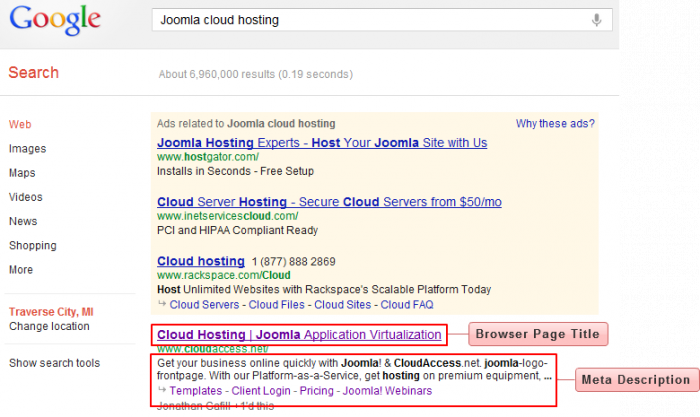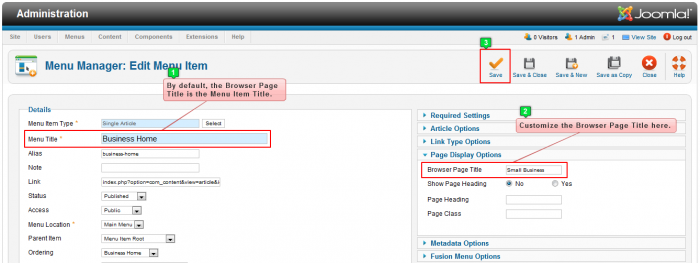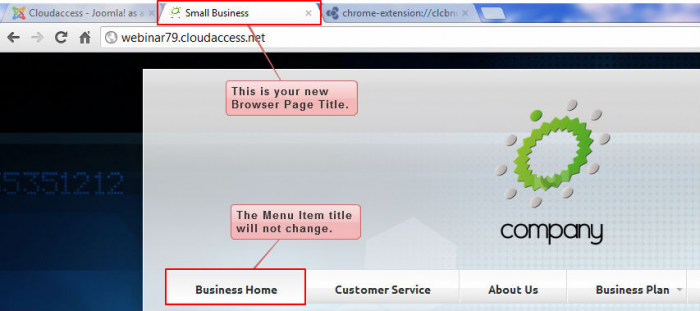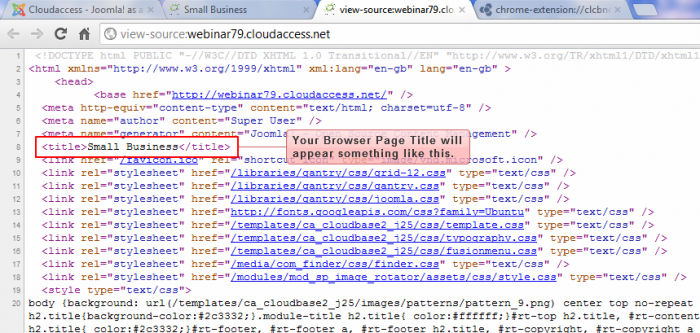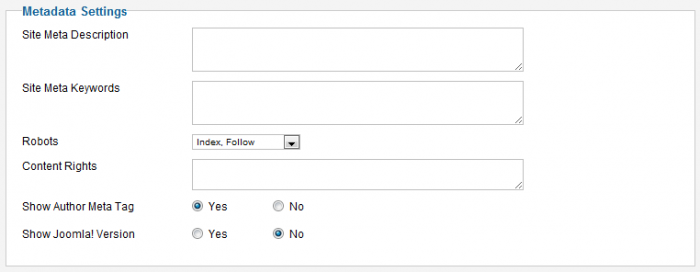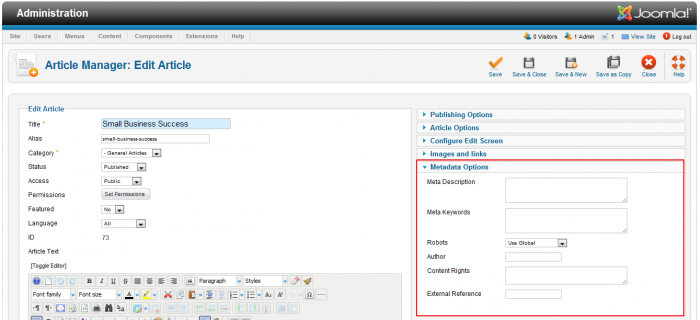Search Engine Optimization (Joomla 2.5)
Search Engine Optimization (SEO) is an incredibly important topic to consider when developing your Joomla Instance, especially if you’d like people to locate you using various search engines. It is important to note that SEO is complicated and continuously changing. What worked last year is different from what works this year. This article offers an overview of SEO, illustrates where to begin enhancing SEO in Joomla, and offers a few additional resources that may be of service.
CloudAccess.net does not specialize in SEO and we are not SEO experts. This is general information that might help someone get started, but know that entire organizations exist to help you enhance your Joomla Instance's SEO and that there are several extensions available at extensions.joomla.org that may also help.
SEO Overview
Browser Page Title
Viewing Page Source
Meta Descriptions
Global Metadata Options
Global SEO Settings
Other Metadata Options
SEO Overview
Search Engine Optimization (SEO) is optimizing (improving the visibility of) your Joomla Instance or individual web pages so that the general public can locate your content on the Internet. When people visit an Internet Search Engine such as Google or Yahoo, they type in a keyword or phrase that is of interest to them. Search engines use web crawling or web spidering as a means to produce accurate and current data when a web search is performed. The search conducted by the web browser produces a SERP, a Search Engine Results Page.
By understanding the different parts of a SERP, one can understand the basics of SEO. There is a Browser Page Title and a Meta Description that will show up within each SERP.
Back to Top
Browser Page Title
In a Joomla Instance, the Browser Page Title is, by default, the title you have given to each Menu Item that you create. You do have the ability to make the Title Tag different than the Menu Item title. Inside the Menu Item, in the parameters area, go to Page Display Options, and create a Browser Page Title. Be sure to save your work.
Return to the front end of your site and refresh the page. The browser tab should show your Browser Page Title, but the title of the Menu Item will remain the same.
It’s important to note that if you’d like the Browser Page Title to be consistent for all pages, you’ll have to repeat this process for each Menu Item on your Joomla Instance.
Back to Top
Viewing Page Source
You can see how your Browser Page Title will appear to search engines if you view the page source information. You can do this by right-clicking your mouse on the web page and selecting the View page source option.
Back to Top
Meta Descriptions
Utilizing the Meta Keywords and Meta Description options within Joomla are great strategies for improving your SEO. This will take some time and effort on your behalf, but, ultimately, search engines like Google and Yahoo may start to index your Joomla Instance. In Joomla, Meta Descriptions and Meta Keywords can be set globally for the entire site or individually for Categories, Articles, or Menu Items.
Back to Top
Global Metadata Options
To begin developing metadata for your entire site, log into the Administration area (the back end) of your Joomla Instance, and go to the Global Configuration area. Under the Site tab, locate Metadata Settings.
By completing these options you’ll add important metadata to each of the pages of your website. This can significantly aid the search rankings and visibility of a website. It’s important to note that metadata won’t be visible to users. It’s also important to note that several of the metadata parameters here may be overridden by metadata content for categories, articles, or menu items. A description of each of the Metadata Options, provided by Joomla.org, is listed below.
Site Meta Description - Text added here appears in web page headers as the “description” metadata entry. The description added here will often times show up in a SERP. A description of around 20 words is recommended. This metadata entry is omitted from web pages if this entry is blank. Because individuals have abused meta keywords (see below) in the past, meta descriptions tend to be more important than the keywords.
Site Meta Keywords - Words and phrases (separated by commas) added here appear in web page headers as the “keywords” metadata entry. Search engines may use these words to refine their indexing of the site s web pages. This metadata entry is omitted from web pages if this entry is blank. It’s extremely important that the keywords reflect the content of the web page. If not, search engine rankings may go down.
Robots - When a spider from a search engine reaches your site, you can actually instruct the spider to index content in different ways by using the Robots drop down menu in Joomla 2.5.
Index, Follow = the spider will index the entire site - the front page and every other page on the site.
No Index, Follow = the spider will not index the front page, but will index every other page on the site.
Index, No Follow = the spider will index the front page, but will not index any other page on the site.
No Index, No Follow = the spider will not index the front page and will not index any page on the site.
Please note that just because you tell a search engine to index some content and not other content, it may not pay attention to you. Trusted search engines will understand this code and will follow directions, but other search engines may not be able to understand the code or simply may not care.
Content Rights - Text added here appears in web page headers as the “rights” metadata entry. If appropriate, describe here what rights others have to use this content. This metadata entry is omitted from web pages if this entry is blank.
Show Author Meta Tag - When this parameter is set to “Yes” an “author” metadata entry is added to the page header when appropriate, using the content item s author name as the metadata text.
Show Joomla Version - If this is set to “Yes”, the version of Joomla that you are using will be indexed along with the content of your Joomla Instance.
Back to Top
Global SEO Settings
There is also SEO Settings within the Global Configuration area. These settings offer a few options for altering the format of URLs for pages within the website, and this may have a significant effect of the search ranking of individual pages. It may also make URLs easier to use and manage for humans. Many of the instructions below also come directly from Joomla.org documentation.
It’s recommended that you do not alter the SEO Settings once a website is established. Changing any of the first three items in this area will mean that nearly all of a site s URLs will also change and result in broken links from other sites and perhaps a temporary drop in search engine rankings.
Search Engine Friendly URLs - Joomla's internal representation of URLs tends to be lengthy and difficult to interpret by humans and search engine spiders. This is a typical example of the internal URL for a page displaying a content item: www.example.com/index.php?option=com_content&view=article&id=22&Itemid=437. If this Global Configuration option is set to “Yes”, the URL is modified into a shorter and more meaningful form: www.example.com/index.php/getting-started. The identifying text in the URL (in this case “getting_started”) is derived from the Alias text set up for each Category, Article, and Menu item. The default setting is “No”.
Use URL rewriting - When this parameter is set to “Yes”, Joomla will use the mod_rewrite function of Apache web servers to eliminate the index.php part of the URL. As a result, the “search engine friendly” URL shown above will become: www.example.com/getting-started.
Adds Suffix to URL - When set to “Yes”, Joomla will add .html to the end of the most site URLs stimulating static file-based web content. The URLs shown above will then become: www.example.com/index.php/getting-started.html or www.example.com/getting-started.html. This setting is largely about personal preferences, but you should remember that it is easy to confuse .htm and .html suffixes when typing URLs. The advantage may lie with having this feature switched off. The default setting is “No”.
Unicode Aliases - By default, your site is set to “Transliteration” which means that when saving edited content, Joomla will attempt to convert, when appropriate, any alias text into the corresponding Latin characters. If you turn “Unicode Aliases” to “Yes”, any non-Latin characters in the alias text will be left unchanged.
Include Site Name in Page Titles - This feature, if set to “Yes” will append the site name to page titles in the <title> tag of each web page header. (This text usually appears in the top bar of the web browser window and/or on the browser tab.)
Other Metadata Options
There is also a Metadata Options area located within the parameters are for each category, article, and menu item that you create for your Joomla Instance. The image below illustrates where to find the Metadata Options area for an article.
Refer to the Metadata Options listed above when creating descriptions or keywords, but you should know that metadata recorded within a category, article, or menu item may override Metadata recorded elsewhere in the Joomla Instance.
Back to Top

Do you have suggestions for improving this article?
We take a great deal of pride in our knowledgebase and making sure that our content is complete, accurate and useable. If you have a suggestion for improving anything in this content, please let us know by filling out this form. Be sure to include the link to the article that you'd like to see improved. Thank you!


